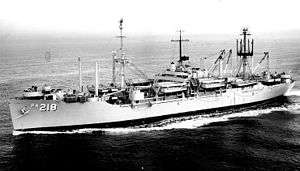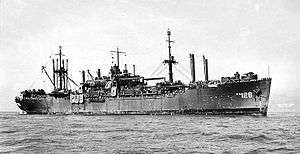Haskell-class attack transport
 USS Noble, a ship of the Haskell class, in 1956 | |
| Class overview | |
|---|---|
| Name: | Haskell class |
| Builders: | |
| Preceded by: | Gilliam class |
| Built: | 1944–1945 |
| In commission: | 11 September 1944 – 29 October 1945 |
| Planned: | 131 |
| Completed: | 117 |
| Cancelled: | 14 |
| General characteristics | |
| Type: | Attack transport |
| Displacement: | 6,873 tons (lt), 14,837 t (fl) |
| Length: | 455 ft (139 m) |
| Beam: | 62 ft (19 m) |
| Draft: | 24 ft (7 m) |
| Propulsion: | 1 × geared turbine (Westinghouse, Joshua Hendy or Allis-Chalmers), 2 × header-type boilers (Babcock & Wilcox or Combustion Engineering), 1 × propeller, designed 8,500 shp (6,338 kW) |
| Speed: | 18–19 knots (33–35 km/h; 21–22 mph) |
| Boats & landing craft carried: | |
| Capacity: |
|
| Complement: | 56 officers, 480 enlisted |
| Armament: |
|
Haskell-class attack transports (APA) were amphibious assault ships of the United States Navy created in 1944. They were designed to transport 1,500 troops and their combat equipment, and land them on hostile shores with the ships' integral landing craft.
The Haskells were very active in the World War II Pacific Theater of Operations, landing Marines and Army troops and transporting casualties at Iwo Jima and Okinawa. Ships of the class were among the first Allied ships to enter Tokyo Bay at the end of World War II, landing the first occupation troops at Yokosuka. After the end of World War II, most participated in Operation Magic Carpet, the massive sealift of US personnel back to the United States. A few of the Haskell class were reactivated for the Korean War, with some staying in service into the Vietnam War.
The Haskell class, Maritime Commission standard type VC2-S-AP5, is a sub‑type of the World War II Victory ship design. 117 were launched in 1944 and 1945, with 14 more being finished as another VC2 type or canceled. Built by the War Shipping Administration under the Emergency Shipbuilding program.
Design
The VC2-S-AP5 design was intended for the transport and assault landing of over 1,500 troops and their heavy combat equipment. During Operation Magic Carpet, up to 1,900 personnel per ship were carried homeward.[Note 1]
The Haskells carried 25 landing craft to deliver the troops and equipment right onto the beach. The 23 main boats were the 36-foot (11 m)-long LCVP. The LCVP was designed to carry 36 equipped troops. The other two landing craft were the 50-foot (15 m)-long LCM (3), capable of carrying 60 troops or 30 tons (27 t) of cargo, or the 56-foot (17 m) LCM (6).[1] They also carried one gig.
The Haskell-class ships were armed with one 5"/38 caliber gun, twelve Bofors 40 mm guns (one quad mount, four dual mounts), and ten Oerlikon 20 mm guns.
Ships of the Haskell class

Haskell-class attack transports included APA-117, USS Haskell, the lead ship, through APA-247, the never completed USS Mecklenburg. The hulls for APA-181 through APA-186 were repurposed to be hospital ships before they were named. Ultimately those hospital ships were built on larger C4 plan and the six VC2 hulls were built in a merchant configuration.[2] APA-240 through APA-247 were named, but cancelled in 1945 when the war ended. With the special exception of USS Marvin H. McIntyre, the Haskell-class ships were all named after counties of the United States.
Fate
Most of the Haskell-class ships were mothballed in 1946, with only a few remaining in service. Many of the Haskell class were scrapped in 1973–75.[3] A few were converted into Missile Range Instrumentation Ships.
USS Gage, the last remaining ship in the Haskell configuration, was scrapped in 2009 at ESCO Marine, in Brownsville, Tx.[4]
USS Sherburne, which was converted and renamed USS Range Sentinel, lasted until she was scrapped in 2012.

See also
Notes
- ↑ See USS Rutland
References
- Class information in Hazegray/DANFS APA-125 page
- MARAD National Defense Reserve Fleet "Current Inventory"
- ↑ USS Lanier (APA-125) Deck Log, September 1945.
- ↑ Friedman, Norman (2002). U.S. Amphibious Ships and Craft. Naval Institute Press. p. 190. ISBN 978-1-55750-250-6. Retrieved 2009-07-13.
- ↑ "Sister Ship Display". Archived from the original on 2011-07-21. Retrieved 2006-09-23.
- ↑
External links
- US Naval Historical Center Photo Library – APA List by Hull Number
- MARAD Records for Haskell class
- Ship Model and Blueprints for Haskell class